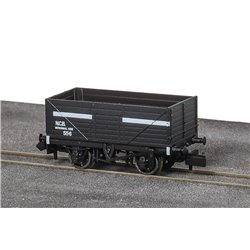If you're modelling the Southern region, the Underground, or any other railway that uses a conductor rail in OO...
No products
Product successfully added to your shopping cart
There are 0 items in your cart. There is 1 item in your cart.
Search Tips
What is a private owner wagon?
In the world of model railways, a private owner wagon refers to a freight wagon that, in real life, was owned by a company rather than the railway itself. During the late 19th and early 20th centuries, this was a common practice across Britain. These wagons were typically used to transport specific goods, often from industries like coal mining, breweries, quarries, and chemical works. The companies that owned these wagons would often paint them in their distinctive liveries, proudly displaying their names, locations and sometimes even advertising slogans.
For model railway enthusiasts, private owner wagons bring a rich layer of authenticity to a layout. Rather than a uniform train of railway-owned stock, having a variety of privately owned wagons adds historical depth and visual interest. It reflects the diversity of industries that depended on the railways to move their goods. Coal, for instance, was one of the most important commodities in the early 20th century, and countless private owner wagons were in use to transport it from collieries to towns and cities across Britain.
One of the charms of modelling private owner wagons is the variety of liveries available. Each company had its own unique branding, often vibrant and eye-catching, which made their wagons stand out. In real life, this branding was both practical and promotional, ensuring the company was recognised while the wagon was in transit or sitting in a goods yard. For the model railway hobbyist, this variety means a wide range of options when building a collection, with different liveries representing real historical companies, from local coal merchants to large-scale industrial firms.
Private owner wagons were most common before nationalisation, as companies were free to own and maintain their own rolling stock. With nationalisation in 1948, many of these privately owned wagons were absorbed into the stock of British Railways or scrapped. However, their legacy lives on in model form, where manufacturers produce an array of wagons replicating those used by businesses throughout Britain. For modellers focusing on pre-nationalisation periods, private owner wagons are essential to accurately represent the goods traffic of the time.
These wagons also provide a fun and rewarding opportunity for customisation. While many manufacturers offer ready-to-run models in popular liveries, some hobbyists enjoy building kits or even custom-painting their own wagons to represent specific companies or fictional businesses that suit their layout. This allows for a more personal touch, giving a model railway layout its own sense of local industry and economy.
In terms of operation, private owner wagons typically operated in loose-coupled freight trains, often hauled by steam locomotives. These trains would travel from industrial centres to distribution hubs, providing a key service in moving bulk goods around the country. Modelling these trains can be quite satisfying, especially if you enjoy replicating real-life operations on your layout, with goods wagons being shunted in and out of sidings, loaded and unloaded and forming part of larger goods trains.
In summary, private owner wagons are a staple of British model railways, offering a glimpse into the industrial history of the UK. Whether you’re looking to build a layout set in the bustling coalfields of Yorkshire or the industrial heartlands of the Midlands, these wagons add historical accuracy and aesthetic appeal. For any model railway enthusiast, they provide a fascinating and diverse element to goods traffic, enhancing both the realism and the enjoyment of the hobby.
Click here to receive the tips weekly in your mailbox. You can unsubscribe at any time.










